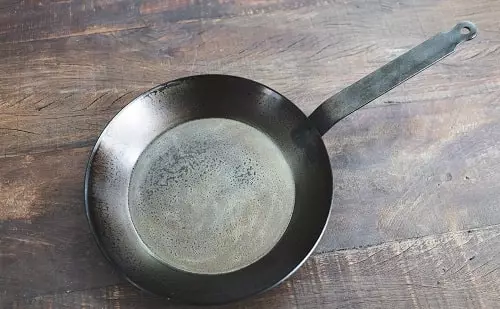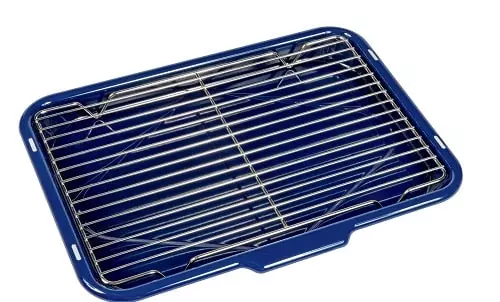The carbon steel pan stands out as a versatile and beloved kitchen tool. Its unique combination of qualities, including heat conductivity, durability, and natural non-stick properties, has earned it a special place in both professional and home kitchens. In this comprehensive guide, we will explore the world of carbon steel pans, offering insights into their definition, types, features, uses, and the myriad of benefits they bring to the culinary realm.
Understanding Carbon Steel Pans:

A carbon steel pan is a type of cookware made from an alloy of iron and a small amount of carbon, typically around 99% iron and 1% carbon. This composition gives carbon steel pans their distinctive properties. They are known for their excellent heat conductivity, which allows for rapid and even heating across the entire cooking surface. Unlike cast iron pans, which can be quite heavy, carbon steel pans are relatively lightweight, making them easier to handle.
Types of Carbon Steel Pans:
- Skillet or Fry Pan: This is the most common type of carbon steel pan, featuring sloped sides and a flat, circular cooking surface. Skillets come in various sizes, from small ones for single servings to larger ones for family meals.
- Wok: Carbon steel woks are favored for their ability to reach high temperatures quickly, making them ideal for stir-frying and deep-frying. They have deep, sloping sides and a rounded bottom.
- Griddle: Carbon steel griddles have a large, flat cooking surface, perfect for making pancakes, crepes, and grilling sandwiches. They often come with handles for easy flipping.
Key Features of Carbon Steel Pans:
- Heat Conductivity: Carbon steel pans are renowned for their exceptional heat conductivity, allowing them to heat up quickly and distribute heat evenly.
- Lightweight: Compared to cast iron, carbon steel pans are relatively lightweight, making them more manageable for everyday cooking.
- Naturally Non-Stick: Over time, when properly seasoned and cared for, carbon steel pans develop a natural non-stick patina that improves with each use.
- Versatility: Carbon steel pans are versatile and can be used for a wide range of cooking techniques, from searing and frying to baking and even roasting.
Uses of Carbon Steel Pans:
- Searing: Carbon steel pans excel at searing meats to perfection, creating a flavorful crust while keeping the interior tender and juicy.
- Stir-Frying: The high heat conductivity of carbon steel makes it an excellent choice for stir-frying, allowing you to quickly cook vegetables and proteins while preserving their texture.
- Baking: Carbon steel pans can be used in the oven for baking dishes like frittatas, quiches, and even pizzas.
- Roasting: You can use a carbon steel pan to roast vegetables, poultry, and other meats, achieving a lovely caramelization.
- Grilling: With its flat cooking surface, a carbon steel griddle is perfect for grilling sandwiches, burgers, and even vegetables indoors.
Benefits of Using a Carbon Steel Pan:
- Rapid Heating: Carbon steel pans heat up quickly and distribute heat evenly, reducing cooking times and ensuring even cooking.
- Natural Non-Stick: With proper seasoning and care, carbon steel pans develop a natural non-stick surface, making them easy to cook with and clean.
- Versatility: These pans can handle a variety of cooking techniques, making them suitable for a wide range of dishes.
- Durability: Carbon steel pans are built to last and can withstand high temperatures, making them ideal for professional kitchens and home use.
- Lightweight: Compared to cast iron, carbon steel pans are easier to handle, making them a favorite among chefs and home cooks alike.
Seasoning and Maintenance:
Proper seasoning and maintenance are essential to the longevity and performance of carbon steel pans. To season a carbon steel pan:
- Clean: Wash the pan with warm, soapy water to remove any manufacturing residues.
- Dry: Thoroughly dry the pan with a clean towel or by heating it on the stovetop.
- Oil: Apply a thin layer of cooking oil (such as vegetable oil or flaxseed oil) to the entire surface, including the handle.
- Heat: Place the pan over medium-high heat until it starts to smoke. This process polymerizes the oil, creating a non-stick layer.
- Cool: Allow the pan to cool completely, and wipe off any excess oil.
To maintain your carbon steel pan:
- After each use, clean it with minimal soap and water and avoid harsh scouring pads.
- Dry the pan thoroughly to prevent rust.
- Re-season as needed to maintain the non-stick surface.
In Conclusion:
A carbon steel pan is a versatile and indispensable tool in the kitchen, favored for its rapid heating, natural non-stick properties, and durability. Whether you’re searing a steak, stir-frying vegetables, or baking a frittata, a well-seasoned carbon steel pan can enhance your cooking experience and produce exceptional results. With the right care and maintenance, a carbon steel pan can become a cherished kitchen companion for generations, elevating your culinary creations to new heights. So, consider adding a carbon steel pan to your kitchen arsenal and embark on a culinary journey where exceptional taste and performance are the norm.

